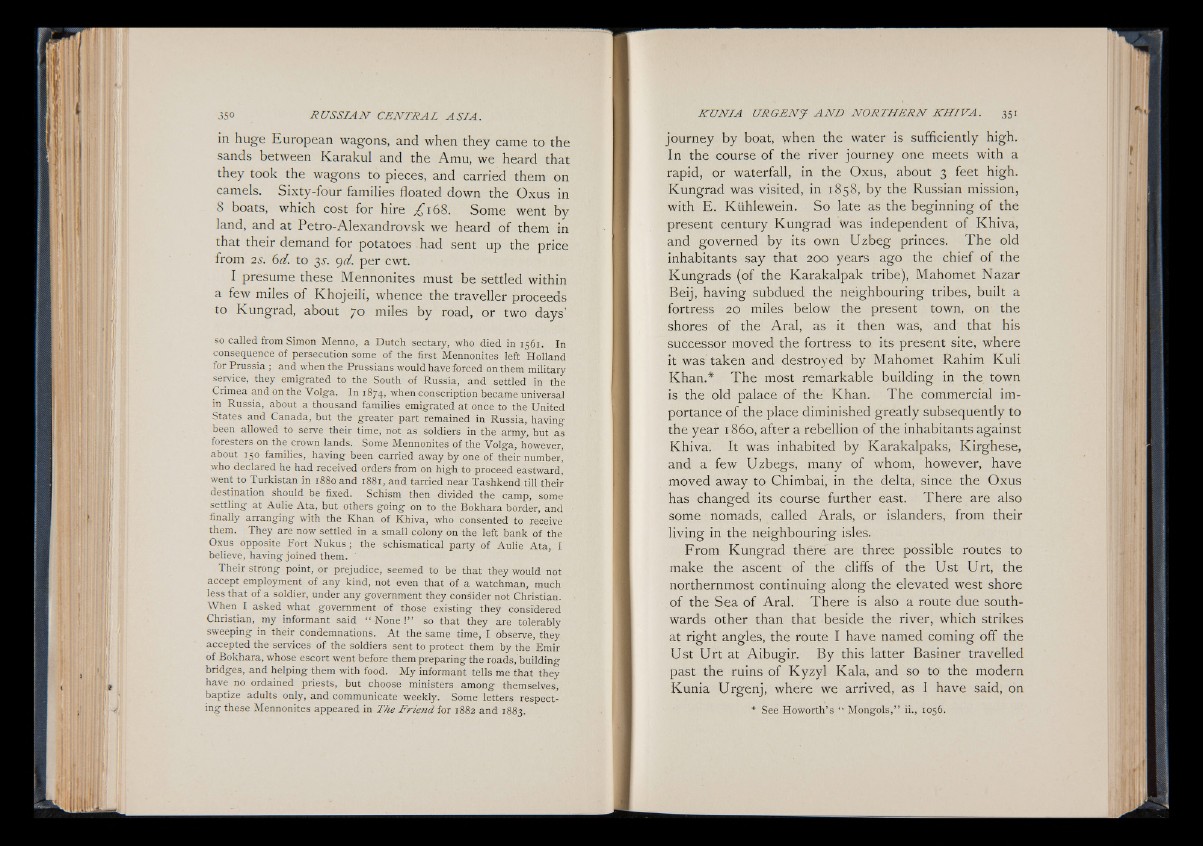
in huge European wagons, and when they came to the
sands between Karakul and the Amu, we heard that
they took the wagons to pieces, and carried them on
camels. Sixty-four families floated down the Oxus in
8 boats, which cost for hire ,£168. Some went by
land, and at Petro-Alexandrovsk we heard of them in
that their demand for potatoes had sent up the price
from 2s. 6d. to $s. gd. per cwt.
I presume these Mennonites must be settled within
a few miles of Khojeili, whence the traveller proceeds
to Kungrad, about yo miles by road, or two days’
so called from Simon Menno, a Dutch sectary, who died in 1561. In
consequence of persecution some of the first Mennonites left Holland
for Prussia ; and when the Prussians would have forced on them military
service, they emigrated to the South of Russia, and settled in the
Crimea and on the Volga. In 1874, when conscription became universal
in Russia, about a thousand families emigrated at once to the United
States and Canada, but the greater part remained in Russia, having
been allowed to serve their time, not as soldiers in the army, but as
foresters on the crown lands. Some Mennonites of the Volga, however,
about 150 families, having been carried away by one of their number,
who declared he had received orders from on high to proceed eastward,
went to Turkistan in 1880 and 1881, and tarried near Tashkend till their
destination should be fixed. Schism then divided the camp, some
settling at Aulie Ata, but others going on to the Bokhara border, and
finally arranging with the Khan of Khiva, who consented to receive
them. They are now settled in a small colony on the left bank of the
Oxus opposite Fort Nukus; the schismatical party of Aulie Ata, I
believe, having joined them.
Their strong point, or prejudice, seemed to be that they would not
accept employment of any kind, not even that of a watchman, much
less that of a soldier, under any government they consider not Christian.
When I asked what government of those existing they considered
Christian, my informant said “ None!” so that they are tolerably
sweeping in their condemnations. At the same time, I observe, they
accepted the services of the soldiers sent to protect them by the Emir
of Bokhara, whose escort went before them preparing the roads, building
bridges, and helping them with food. My informant tells me that they
have no ordained priests, but choose ministers among themselves,
baptize adults only, and communicate weekly. Some letters respecting
these Mennonites appeared in The Friend for 1882 and 1883.
journey by boat, when the water is sufficiently high.
In the course of the river journey one meets with a
rapid, or waterfall, in the Oxus, about 3 feet high.
Kungrad was visited, in 1858, by the Russian mission,
with E. Kiihlewein. So late as the beginning of the
present century Kungrad was independent of Khiva,
and governed by its own Uzbeg princes. The old
inhabitants say that 200 years ago the chief of the
Kungrads (of the Karakalpak tribe), Mahomet Nazar
Beij, having subdued the neighbouring tribes, built a
fortress 20 miles below the present town, on the
shores of the Aral, as it then was, and that his
successor moved the fortress to its present site, where
it was taken and destroyed by Mahomet Rahim Kuli
Khan.* The most remarkable building in the town
is the old palace of the Khan. The commercial importance
of the place diminished greatly subsequently to
the year i860, after a rebellion of the inhabitants against
Khiva. It was inhabited by Karakalpaks, Kirghese,
and a few Uzbegs, many of whom, however, have
moved away to Chimbai, in the delta, since the Oxus
has changed its course further east. There are also
some nomads, called Arals, or islanders, from their
living in the neighbouring isles.
From Kungrad there are three possible routes to
make the ascent of the cliffs of the Ust Urt, the
northernmost continuing along the elevated west shore
of the Sea of Aral. There is also a route due southwards
other than that beside the river, which strikes
at right angles, the route I have named coming off the
Ust Urt at Aibugir. By this latter Basiner travelled
past the ruins of Kyzyl Kala, and so to the modern
Kunia Urgenj, where we arrived, as I have said, on
* See Howorth’s “ Mongols,” ii., 1036.